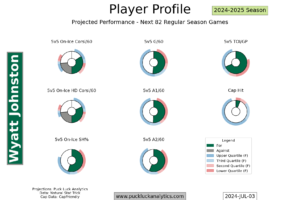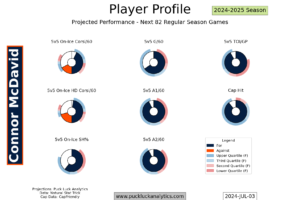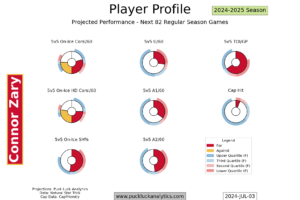There’s a prevailing mindset among both NHL teams and NHL fans that a team should either be contending or rebuilding. I’ve long thought that to be a strange dichotomy. In no other business would an entity strive for excellence only when circumstances permitted. There must be a better way.
Considering the inherent randomness that can define postseason success and the desire to achieve sustainable long term success, perhaps there is a better way. I’m going to term this philosophy Roster Regeneration. Let’s explore.
The Problem With Being “All-in”
Assuming we have a roster capable of contending for a Stanley Cup, the current prevailing mindset around the NHL seems to be an “All-in” mentality. If we’re in this position, we should seemingly unload whatever prospects and picks are necessary to make marginal upgrades to our roster with the hope (keyword “hope”) that it will put this year’s group over the top.
The fact that 16-20 teams are all doing the same thing isn’t even the biggest issue with this philosophy. More problematic is the fact that we may give up large amounts of future potential to add a veteran 3rd pair defenseman who doesn’t really move the needle for our Stanley Cup aspirations.
Survey the major public models and make a note of the chance they give the cup favorites of bringing home Lord Stanley’s mug this spring. It’s unlikely to be more than ~15-20% for the best teams in the NHL at any time prior to the start of the playoffs. It’s not even close to a coin flip.
In other terms, we should expect to need a window of multiple seasons just to have a reasonable chance at winning a Stanley Cup. Even if we could put together a roster that had a 20% chance of winning it all every year, we’d need 3 seasons to get coin flip odds on winning a single Stanley Cup. At a 15% chance per season, it’s 4 years for coin flip odds.
Now, back to the “all-in” mindset. If we mortgage the future to marginally improve our odds at a cup in a single season, we’ve already lost the plot. We need to build toward a 5 year window of opportunity.
The Trouble with “Rebuilding”
If we don’t have a roster capable of contending, the prevailing philosophy around the league suggests that we should tear the team down to the studs and rebuild. Future assets are of seemingly infinite value while current capable NHL players are only preventing us from tanking properly.
Sometimes, it works. Clearly, landing a few picks at the top of the draft to add elite talent can provide a foundation for years to come. Yet this approach takes years to come to fruition. One wrong turn can delay, or even reset, the recovery. And if we do manage to reach rock bottom and finish last in the NHL standings, we now have 31 other teams that are better than us that we need to leapfrog to become the class of the league. They aren’t simply going to step aside and let us pass. Not only that, but we risk allowing a culture of losing to permeate the organization which may result in even greater difficulty climbing back up the standings.
Retool?
We hear the term retooling around the league when teams still think they have some good pieces but have found themselves stuck near the playoff bubble. It’s an admission that the team isn’t good enough to contend. It’s also a refusal to start the tear down for a rebuild.
It’s a reasonble thought process. We’re close. If we make a few tweaks, maybe we can nudge this roster over the top. Yet it often doesn’t work. Most of the teams we hear this language coming from end up stuck in mediocrity. There are often band-aid solutions applied in an attempt to patch holes in the roster without a solid long term vision.
Regenerative Roster Construction Framework
I think there’s a better way. Our goal is to create a roster that is capable of contending for a Stanley cup over 5 year periods, while regenerating the roster to set up future contention windows at the same time.
Key Players
Ideally, we’d like to have a few key players capable of anchoring the team for a decade or longer. While we may be able to get by without these players, they’re certainly a valuable asset if we can land them.
We’re looking at only 1-2 forwards, 1 defensemen, and potentially a goaltender here. A tough year leading to a high 1st round pick is the obvious method to acquire these players, but not the only one. We may hit a home run with a later pick or land a big free agent.
Here are a few examples from some the dominant teams in the salary cap era:
- Crosby/Malkin/Letang
- Teows/Kane/Keith
- Kopitar/Doughty/Quick
- Kucherov/Hedman/Vasilevskiy
- Bergeron/Marchand/Rask
- MacKinnon/Makar
Our goal is to lock up these players for as long a term as possible. We know they’ll be impactful for years and locking them up early gives us a foundation to build around that comes with cost certainty.
Core Players
Next, we’re looking for core players to complement the key players. We’re looking to add 3-5 forwards, 2-3 defensemen and a goaltender (if we don’t have one in our key group). With this group in place, we’d like to round out our top 6 forward group (and potentially a 3rd line center), have 3-4 defensemen to anchor the blueline, and have a starting goaltender..
We don’t need these players to be franchise players. Players hit their peak roughly between the age of 25 and 30. During that time, their impact is relatively stable which gives us about a 5 year window where we get their best performance.
We’d like to acquire a cohort of players that will hit their prime within a couple of years of each other. That gives us a group of players providing their maximum impact at the same time. Our contention window is the period when this group is providing peak performance.
Regenerating the Core
If we’re going to avoid a full tear down and rebuild after the current core starts to decline, we need a sustainable method to replace core players as they reach the end of their peak years. This is where we use our future assets. We want to build a future core cohort, starting while our current core is just entering their prime.
Our goal is to use our draft capital to acquire prospects that can grow into the next core cohort. It’s important that we don’t put all our eggs in one basket, though. There aren’t many prospects that we can consider a sure thing so we’ll want to have multiple prospects in the system for each position we need to eventually fill at the NHL level.
It would also be beneficial to execute trades to consolidate our draft capital within a 2-3 year period. The prospect that develops between the timing of our contention cohorts may still be valuable, but it won’t help us maximize the potential of our roster.
Outside Help
Prospect development is not linear and there’s a good chance we’ll need to supplement our contention cohorts with help from the outside. Free agency and trades give us the tools to do this, but we want it to be a last resort.
Homegrown talent gives us the best chance of grouping players to hit their prime together, while also hitting some high value contracts when players on ELCs are able to push their way onto the NHL roster.
Free agency should be our next option, given we don’t have to give up assets to add players in this manner. It’s often more expensive though, so we want to tread carefully and only fill holes when we truly don’t have an internal option coming up through the system.
Trades are a last resort. If we don’t have all the players we need in our contention cohort, we need to add them somehow or we’re bound for mediocrity. If they aren’t available in free agency, we’ll have to part with some assets to fill those holes.
Depth Details
We haven’t mentioned depth players until this point, simply because they are the final details that we need to concern ourselves with. If we don’t have a core that’s capable of contending, it doesn’t matter what our depth looks like.
The key to our depth is finding short term, high value contracts. We don’t want to commit term or money to depth players so we don’t back ourselves into a corner in keeping our contention cohorts together. We want a mix of veterans and youth, providing experience, opportunity and mentorship for our next contention cohort. We may keep some of our previous cohort around in lesser roles provided the price is right. We’ll allow our prospects to compete for NHL roster spots to gain valuable experience and provide impact with low cap hits.
Long Term Sustainability
By no means is this a simple strategy to execute. But if it’s done right, I think it can lead to long term sustainable success. With contention cohorts spaced 5-7 years apart, we create contention windows where our roster is at it’s maximum potential. In between, we should expect a 2-3 year transition period between our contention cohorts. Expectations should be tempered during these periods but we should still have a team capable of making the playoffs and we can use these periods to focus on adding long term value with an eye on our next contention window.



